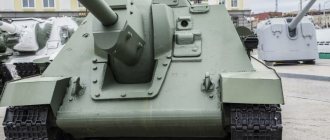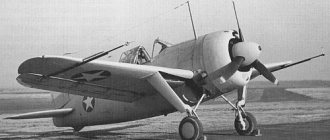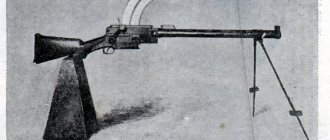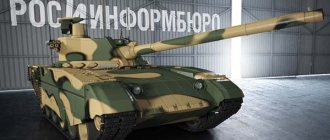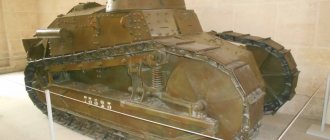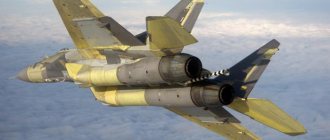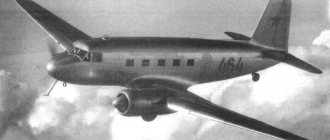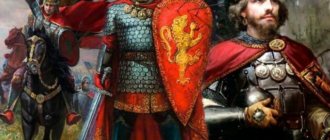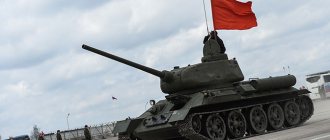There are combat vehicles (including tanks) that have not achieved any special military feats or exceptionally long service. Sometimes they are little known and were released in small series.
This is exactly the fate that befell the Soviet T-44 tank. It was developed during the Great Patriotic War, but never made it to the front; it was discontinued after a few years and was not exported. The merit of this tank lies elsewhere. It was on it that solutions were first applied and tested, which later formed the basis for the design of more famous and widespread post-war tanks.
History of creation and device
Despite all the advantages of the T-34, great potential for modernization was not one of them. The experience of creating the T-43 has shown that it will not be possible to improve combat qualities with “little blood.” And in 1943, the armor, invulnerable to 37- and 50mm guns, was already easily penetrated by 75 and 88mm guns. And the designers, led by Alexander Morozov, began to create a new tank, reliably protected from German guns, but maintaining the mobility of the Thirty-Four.
The only way to strengthen the armor without increasing the mass of the combat vehicle was to reduce the size of the hull, and specifically its height. The “interior” was seriously rearranged, and the main innovation was the transverse placement of the B-44 engine. The cooling system radiators were compactly installed behind the engine, above the transmission units. As on the T-43, the spring suspension was replaced with torsion bars. As a result of the changes, the fighting compartment, despite the lower body, became more spacious.
The abolition of the ball mounting of the machine gun in the front plate and the transfer of the radio station to the commander's disposal made the gunner-radio operator unnecessary.
Its place was taken by a gas tank and part of the ammunition. Another fuel tank was located in the partition between the engine and fighting compartments. The turret has moved to the center of the hull, thereby improving weight distribution.
The V-44 engine was not completely new - it was a proven V-2-IS tank diesel engine with a new fuel supply system. Its power increased from 500 to 520 hp. Torque from the engine to the gearbox installed in parallel was transmitted through an overdrive gearbox. The turning mechanisms and main gear remained the same as on the T-34.
The thickness of the frontal armor plates, compared to the T-34, has doubled - to 90mm. The sides reached 75mm. The armor of the turret's forehead was increased to 120 mm, and its sides to 90. In fact, in terms of protection, the T-44 came close to heavy tanks, only slightly inferior to the IS-2 in terms of the thickness of the frontal armor. The first prototypes retained a weakened zone in the front sheet - the driver's cabin. This has been eliminated on production cars.
Experienced T-44s were tested in two versions.
The first was armed with the 85mm D-5 cannon, tested on HF and IS. They tried to qualitatively strengthen the firepower of the other by installing a 122mm D-25 gun. For installation in a medium tank, the gun was redesigned and made lighter, and separate loading was replaced by unitary shots. At the same time, the ammunition supply was halved - from 58 to 24 rounds.
The breech of the gun, although reduced, took up too much space in the turret, and the unitary shots turned out to be too heavy and large. So, according to the test results, the “heavy” option was abandoned.
Serial T-44s were armed with an 85mm gun, but not the D-5, but the ZIS-S-53. Its BR-365K armor-piercing projectile penetrated up to 145 mm of armor; the anti-corrosion effect was provided by a charge of 48 grams of hexal. The BR-365P sub-caliber projectile did not have an explosive charge, but penetrated up to 180mm of armor. In the post-war period, the ammunition supply was replenished with shells from the BR-367 family. The armor penetration of the chamber projectile was increased to 159mm, and that of the sub-caliber projectile to 230mm. The O-365K high-explosive fragmentation grenade weighing 9.5 kg contained 660 grams of TNT.
The DT 7.62mm machine gun, coaxial with the cannon, remained unchanged. But the course machine gun was preserved, despite the absence of a radio operator and installation. Now it was rigidly installed in the front plate, and the driver fired from it remotely.
Crew:
- Crew commander;
- Gunner;
- Driver mechanic;
- Loader (Radio Operator).
Learning additional skills for the crew:
Standard crew for Active Actions:
| 1 | 2 | 3 | 4 |
For the first slot, we teach all crew members, except the commander, the “ Repair” , and for the commander the “ Sixth Sense” skill - the “Repair” skill speeds up the repair of damaged modules, and the “Sixth Sense” will allow you to determine whether his tank has been detected by the enemy. Also, all crew members need to learn the additional skill “ Combat Brotherhood” , which will improve the level of proficiency in the specialty - be sure to learn it all at once, preferably used in the second or third slot.
- the Eagle Eye skill , which increases the viewing range.
- For the gunner we learn the skill “ Smooth turret rotation” , which reduces the spread when turning the turret; and the Sniper , which increases the chances of causing damage to modules and crew members.
- For the driver mechanic, we learn the “ Smooth Move” , which reduces the dispersion of the gun in motion; and the Off-Road King , which reduces drag on soft to medium ground when driving.
- For the radio operator we learn the skill Radio Interception , which increases the viewing range; and the Inventor , which increases the communication range of the radio station by 20% .
- For the loader, we learn the skill “Non-contact ammo rack ,” which increases the strength of the ammo rack; and the Radio Interception , which increases viewing range.
Studying skills and abilities of crew members for defense:
| 1 | 2 | 3 | 4 |
For the first slot, we teach all crew members the “ Camouflage” , and for the commander the “ Sixth Sense” skill - the “Camouflage” skill will reduce the overall visibility of the tank, and the “Sixth Sense” will allow you to determine whether his tank is detected by the enemy. Also, all crew members need to learn an additional skill “ Combat Brotherhood” , which improves the level of proficiency in the specialty, must be studied by everyone at once, preferably used in the second or third slot.
- the Eagle Eye skill , which increases the viewing range.
- For the gunner we learn the skill “ Smooth turret rotation” , which reduces the spread when turning the turret; and the Sniper , which increases the chances of causing damage to modules and crew members.
- For the driver mechanic, we learn the “ Smooth Move” , which reduces the dispersion of the gun in motion; and the Off-Road King , which reduces drag on soft to medium ground when driving.
- For the radio operator we learn the skill Radio Interception , which increases the viewing range; and the Inventor , which increases the communication range of the radio station by 20% .
- For the loader, we learn the skill “Non-contact ammo rack ,” which increases the strength of the ammo rack; and the Radio Interception , which increases viewing range.
Production and operation
The T-44 was put into service in 1944, but only small-scale production began. Firstly, large-scale offensive operations required a lot of equipment, and an attempt to organize the production of new vehicles threatened to disrupt the pace of production of the Thirty-Fours. Secondly, having better hull armor, it was identical in armament to the T-34-85. Therefore, the question of the need for a tank with a more powerful weapon arose immediately. In addition, it was planned to further strengthen the armor, especially the tower.
In 1945, prototypes of the T-44-100 tank with 100mm guns were made, but it did not go into production.
Tests of the tank with the D-10 gun showed that the gun was unbalanced and its recoil was too strong for the T-44. The version with the LB-1 gun, equipped with a muzzle brake, performed better. The generals were not satisfied with the muzzle brake itself. It was believed that clouds of dust and gases formed when firing from a gun with a muzzle brake would unacceptably unmask the tank. As a result, all work was stopped in favor of creating a new T-54.
Production of the T-44 ceased in 1948; less than two thousand vehicles were assembled. They remained in service until the end of the 1970s. In the early 1960s, the T-44s were upgraded to the T-44M standard. They were equipped with night vision devices, and the chassis was unified with the T-54. In 1966, the remaining T-44s in service received weapon stabilizers. All these years, tanks were most often used as training tanks.
The T-44 never made it to the front of the Great Patriotic War (at least to the real one). The only military operation in which tanks managed to take part was the suppression of the uprising in Hungary. But decommissioned tanks found use at Mosfilm. Based on them, models of the German Pz-IV and Tigers were made, which can be seen in a number of Soviet military films.
On the basis of the T-44, experimental artillery self-propelled guns SU-101 and SU-102 were built in 1945.
After the end of the war, work on them was stopped. The only mass-produced vehicle on the T-44 chassis was the BTS-4 evacuation tractor, developed in 1965. The turret with weapons was removed from the tank, it was equipped with a loading platform, a traction winch and a crane. The obsolete T-54 and IT-1 missile tanks were also converted in a similar way.
Tactical and technical characteristics of the T-44
To compare technical characteristics, let's take medium tanks developed in the last years of the war - the American M26 Pershing and the British Centurion. Note that the Pershing was considered a heavy tank for some time, and only after the war it was finally recognized as a medium tank.
| T-44 | M26 | "Centurion" Mk.1 | |
| Weight, t | 31,8 | 41,6 | 48,7 |
| Frontal armor, mm | 90 | 101 | 76,2 |
| Side armor, mm | 75 | 76 | 51 |
| Armament | 85mm cannon, 2x 7.62 mm machine guns | 90mm cannon, 12.7mm machine gun, 2x 7.62mm machine guns | 76mm cannon, 7.92mm machine gun |
| Maximum speed, km/h | 60 | 45 | 39 |
It follows from the figures that the T-44, while not inferior to the American one in firepower and protection, left it far behind in mobility. The T-44 was lighter and, due to its smaller size, less noticeable than the M26. But the Centurion, while surpassing both the Soviet and American tanks in mass, was inferior to them in both armament and armor. At least this applies to early series cars.
"Pershing" in a sense repeated the path of the T-44. Having managed to fight in 1945, he quickly left the scene, giving way to the “Patton” family created on its basis. The fate of the Centurions turned out to be more interesting. Modernizing and rearming, they were in service with a dozen countries until the 1980s, and in South Africa, under the name "Oliphant", they are still used.
Despite the fact that the T-44 “took root” in cinema, it usually “played” “Germans” there, and therefore did not become known to the general public. Even the role of himself - for example, in the film "Father of a Soldier", he was not made famous due to his low prevalence and short service life. Only recently has interest in the T-44 increased due to the massive popularity of online games on tank themes.
The T-44, unlike the T-43, turned out to be not an attempt to seriously modernize the T-34, but a new page in Soviet tank building.
Only a few parts are similar to the T-34. A completely different hull, powerful armor, a different layout, torsion bar suspension - this made the T-44 a different tank.
It was the experience gained during the creation of the T-44, the solutions used in it, that made it possible to quickly prepare an even more advanced machine - the T-54, the “descendants” of which are still in use today.
Fight for quantity
If before the start of the war the production of T-34 medium tanks was carried out at well-equipped factories No. 183 in Kharkov and STZ in Stalingrad, then their evacuation to the Urals and the loss of many factories supplying components and materials created enormous difficulties for the high-quality production of tanks. However, the leadership of the People's Commissariat of Tank Industry (NKTP), formed on September 12, 1941, in accordance with the decision of the State Defense Committee (GKO), persistently demanded an increase in the number of tanks produced. The designers of the Kharkov tank KB-520 (A. Morozov became its leader after Koshkin’s death in 1940), evacuated along with plant No. 183, were thrown into the struggle to improve the production technology of the T-34, to save non-ferrous metals, rubber, armor steel, and even electrical wires. This work took all the strength of a small team, which consisted of only 130 designers.
Naturally, in such harsh conditions of the struggle for the quantity and quality of produced tanks inevitably decreased, and the inherent shortcomings of the "thirty-four" became more acute - the imperfection of the gearbox (gears were very difficult to change - for example, the effort required to switch from second to third gear was more than 30 kg), low reliability of the V-2 engine (the service life of wartime diesel engines was initially less than 100 hours).
In addition, already in December 1941, the military demanded to significantly strengthen the armor protection of the T-34 with a minimal increase in its weight. Thickening the armor was supposed to increase the tank's protection against damage from new ammunition that appeared in service with the German army. Taking into account the requirements of the military, A. Morozov instructed a group of designers to carry out the design development of an improved “thirty-four”. The project was based on the following provisions: while maintaining the main mechanisms and components of the T-34 tank and limiting the weight of the vehicle to 35 tons, sharply increase the thickness of the armor - from 45 mm to 75 mm (due to a denser layout and the elimination of the fourth crew member). It was planned to implement the design reserve accumulated by the design bureau back in 1940 during the development of the T-34M tank. The pre-war design of the T-34M tank provided for significantly strengthening the armor protection of the hull and turret, bringing it to 75 mm and 90 mm, respectively. To compensate for the increased mass of armor, the chassis was radically redesigned - the heavy and bulky spark plug suspension (passed on to the T-34 by inheritance from the Christie tank and BT) was abandoned. Instead, a torsion bar suspension was adopted, with lightweight, small-diameter road wheels with internal shock absorption. Reduced by one person and crew (the loader was abandoned). At the end of 1940, the Zhdanov plant even produced armor plates for five sets of T-34M hulls. However, the large amount of work to prepare for mass production of the T-34 led to the fact that work on the T-34M tank was suspended.
The project for an improved T-34 was submitted to the NKTP in February 1942, but was not approved. In the difficult military situation of that period, the leadership of the People's Commissariat considered that it was not yet time to deal with a new vehicle, and KB-520 was instructed to continue work on improving the design and production technology of the serial T-34.
